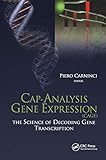Cap-analysis gene expression (CAGE) : the science of decoding gene transcription / editor, Piero Carninci.
Material type: TextPublication details: Singapore : Pan Stanford, c2010.Description: xv, 266 p. : ill. (some col.)ISBN:
TextPublication details: Singapore : Pan Stanford, c2010.Description: xv, 266 p. : ill. (some col.)ISBN: - 9789814241342 (hbk.)
- 9814241342 (hbk.)
- Cap analysis gene expression (CAGE)
- 572.86 CAP
| Item type | Current library | Home library | Call number | Status | Date due | Barcode | |
|---|---|---|---|---|---|---|---|
 Book
Book
|
Dept. of Biochemistry Processing Center | Dept. of Biochemistry | 572.86 CAP (Browse shelf(Opens below)) | Available | BCH2949 |
Browsing Dept. of Biochemistry shelves, Shelving location: Processing Center Close shelf browser (Hides shelf browser)

|

|
No cover image available No cover image available |

|
No cover image available No cover image available |

|

|
||
| 572.83 NEI-P Principles of nucleic acid structure / | 572.838 DEH-M;3 Molecular Biotechnology | 572.86 BHA Molecular genetics/ | 572.86 CAP Cap-analysis gene expression (CAGE) : the science of decoding gene transcription / | 572.86 DIE-P PCR primer: Laboratory manual | 572.86 FAR-R RNA Methodologies: A Laboratory Guide for Isolation and Characterization | 572.86 MUK-H Handbook of Bioinformatics/ |
Includes bibliographical references and indexes.
Cap analysis gene expression (CAGE) -- Tagging transcription starting sites with CAGE -- Construction of CAGE libraries -- Transcriptome and genome characterization using massively parallel paired end tag (PET) sequencing analysis -- New era of genome-wide gene expression analysis -- Computational tools to analyze CAGE -- Extraction and quality control of CAGE tags -- Setting CAGE tags in a genomic context -- Using CAGE data for quantitative expression -- Databases for CAGE visualization and analysis -- Computational methods to identify transcription factor binding sites using CAGE information -- Transcription regulatory networks analysis using CAGE -- Gene-expression ontologies and tag-based expression profiling -- Lessons learned from genomic CAGE -- Future challenges in CAGE analysis -- Comparative genomics and mammalian promoter evolution -- The impact of CAGE data on understanding macrophage transcriptional biology.
"The ouput of eukaryotic genomes is much more complex than expected. Genes produce different variants of RNAs from multiple promoters. One of the ultimate targets of biological analysis is to establish a relationship between the messenger RNAs that are transcribed from the genome and the genomic regions that control their expression - the promoters - in order to decipher the networks that regulate gene expression and the transcription factors that act as master regulators of transcriptional control."
"Novel technologies have recently appeared that allow deciphering of transcriptional network, based on the identification of the starting site of gene transcription, with the simultaneous measurement of expression level and identification of the promoter elements. These tagging technologies (including cap-analysis gene expression - CAGE - and others) are further boosted from the development of the novel generation of sequencing instruments, which allow transcriptional profiling by sequencing at the cost of microarray experiments.".
"This book is a guide for users of new technologies, as it includes accurately proven protocols, allowing readers to prepare their samples for experiments. Additionally, it provides a guide for the bioinformatics tools that are available for the analysis of the obtained tags, including the design of the software, the sources and web information where they can be downloaded. Finally, the book provides examples of the application of these technologies to identify promoters, annotate genomes, identify new RNAs and reconstruct models of transcriptional control. Although examples mainly regard mammalians, the discussion expands to other groups of eukaryotes, where these approaches are complementing genome sequencing"--P. [4] of cover.
There are no comments on this title.

